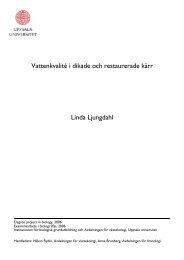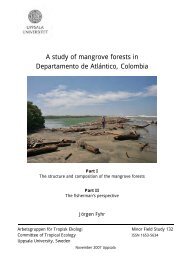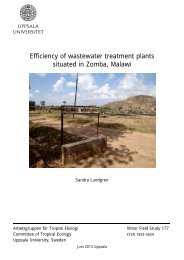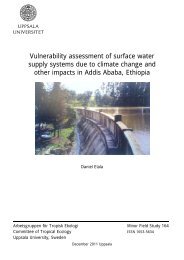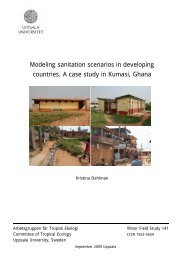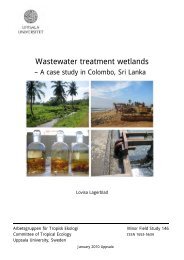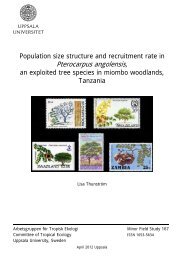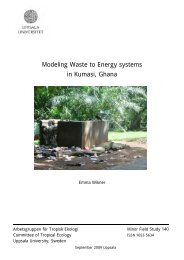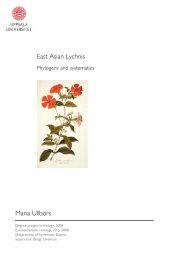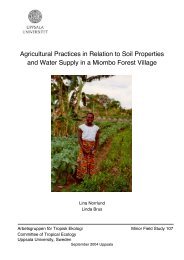Butterflies as indicators of forest quality in miombo woodlands ...
Butterflies as indicators of forest quality in miombo woodlands ...
Butterflies as indicators of forest quality in miombo woodlands ...
You also want an ePaper? Increase the reach of your titles
YUMPU automatically turns print PDFs into web optimized ePapers that Google loves.
<strong>Butterflies</strong> <strong>as</strong> <strong><strong>in</strong>dicators</strong> <strong>of</strong> <strong>forest</strong> <strong>quality</strong><br />
<strong>in</strong> <strong>miombo</strong> <strong>woodlands</strong>, Tanzania<br />
EvaLotta Nordqvist<br />
Arbetsgruppen för Tropisk Ekologi M<strong>in</strong>or Field Study 137<br />
Committee <strong>of</strong> Tropical Ecology ISSN 1653-5634<br />
Uppsala University, Sweden<br />
February 2009 Uppsala
<strong>Butterflies</strong> <strong>as</strong> <strong><strong>in</strong>dicators</strong> <strong>of</strong> <strong>forest</strong> <strong>quality</strong><br />
<strong>in</strong> <strong>miombo</strong> <strong>woodlands</strong>, Tanzania<br />
EvaLotta Nordqvist<br />
Degree project <strong>in</strong> biology, M<strong>as</strong>ter <strong>of</strong> science (1 year), 2009<br />
Examensarbete i biologi 30 hp till magisterexamen, 2009<br />
Biology Education Centre and Department <strong>of</strong> Ecology and Evolution, Animal Ecology, Uppsala University<br />
Supervisors: Göran Milbr<strong>in</strong>k and Håkan Hytteborn
Table <strong>of</strong> contents<br />
Abstract…………………………………………………………………………... 2<br />
Introduction……………………………………………………………………… 3<br />
Material and method……………………………………………………………. 5<br />
- Study site……………………………………………………….. 5<br />
- Data collection………………………………………………….. 5<br />
- Data analysis……………………………………………………. 5<br />
Results……………………………………………………………………………. 7<br />
Discussion………………………………………………………………………… 13<br />
- Composition <strong>of</strong> species………………………………………… 13<br />
- Distribution <strong>of</strong> species…………………………………………. 14<br />
- Methods………………………………………………………… 15<br />
- Species diversity……………………………………………….. 15<br />
- Conclusions……………………………………………………. 16<br />
- Acknowledgements……………………………………………. 16<br />
References…………………………………………………………. ……………. 17<br />
Appendix I……………………………………………………………………….. 19<br />
Description <strong>of</strong> study sites<br />
Appendix II……………………………………………………………………… 21<br />
Map over the study sites<br />
Appendix III…………………………………………………………………….. 22<br />
List <strong>of</strong> species<br />
Appendix IV……………………………………………………………………... 23<br />
Assumed preference <strong>of</strong> habitat<br />
Appendix V……………………………………………………………………… 24<br />
Photos <strong>of</strong> butterflies<br />
1
Abstract<br />
Miombo <strong>woodlands</strong> <strong>in</strong> Africa are biomes dom<strong>in</strong>ated by species <strong>of</strong> the genera Brachystegia,<br />
Julbernardia and Isoberl<strong>in</strong>ia. In Tanzania the <strong>woodlands</strong> provide the people with many<br />
important ecosystem goods and services, but due to the <strong>in</strong>cre<strong>as</strong><strong>in</strong>g pressure on these<br />
resources, <strong>miombo</strong> <strong>woodlands</strong> are rapidly be<strong>in</strong>g de<strong>forest</strong>ed and degraded. <strong>Butterflies</strong><br />
(Lepidoptera) are very sensitive to changes <strong>in</strong> the environment and are strongly <strong>as</strong>sociated<br />
with vegetation structure and composition, which makes them very useful <strong>as</strong> <strong><strong>in</strong>dicators</strong> for<br />
different ecological studies. The method <strong>of</strong> us<strong>in</strong>g butterflies <strong>as</strong> <strong><strong>in</strong>dicators</strong> <strong>of</strong> <strong>forest</strong> disturbance<br />
w<strong>as</strong> tested dur<strong>in</strong>g two months <strong>in</strong> <strong>miombo</strong> <strong>woodlands</strong> <strong>in</strong> the Kilosa district outside Mikumi<br />
National Park, <strong>in</strong> the e<strong>as</strong>t-central part <strong>of</strong> Tanzania. Ten study sites with different degrees <strong>of</strong><br />
disturbances were <strong>in</strong>vestigated, <strong>in</strong> each <strong>of</strong> which 4 transects <strong>of</strong> 100x10 metres were<br />
established. <strong>Butterflies</strong> were observed while walk<strong>in</strong>g along these transects, record<strong>in</strong>g<br />
butterflies either on the w<strong>in</strong>g or by us<strong>in</strong>g a net. Three butterfly traps <strong>of</strong> the bee-hive model<br />
baited with rotten banana were hung up along each transect to attract frugivorous species.<br />
Tree density and gr<strong>as</strong>s- and bush cover w<strong>as</strong> estimated on each site. <strong>Butterflies</strong> were identified<br />
and divided <strong>in</strong>to three groups (<strong>forest</strong>, gr<strong>as</strong>sland, and generalist) depend<strong>in</strong>g on their habitat. A<br />
total <strong>of</strong> 56 species were recorded, 15 <strong>of</strong> which, accord<strong>in</strong>g to literature, were <strong>forest</strong> species, 15<br />
were gr<strong>as</strong>sland species, 18 were generalists, and 8 have unknown habitat preferences. When<br />
study<strong>in</strong>g some <strong>of</strong> the most important <strong>in</strong>dicator species, one <strong>of</strong> the are<strong>as</strong> show signs <strong>of</strong> be<strong>in</strong>g a<br />
less disturbed <strong>forest</strong>. In contr<strong>as</strong>t to several previous studies with butterflies <strong>as</strong> <strong><strong>in</strong>dicators</strong> <strong>of</strong><br />
environment disturbance, no significant differences <strong>in</strong> diversity or species richness could be<br />
found between different plots represent<strong>in</strong>g various degrees <strong>of</strong> disturbance.<br />
2
Introduction<br />
Miombo <strong>woodlands</strong> are <strong>forest</strong> land dom<strong>in</strong>ated by species <strong>of</strong> the genera Brachystegia,<br />
Julbernardia and Isoberl<strong>in</strong>ia. In Africa, <strong>miombo</strong> <strong>woodlands</strong> cover an area <strong>of</strong> about 2.7<br />
million km 2 , rang<strong>in</strong>g from the south to the central and e<strong>as</strong>tern parts <strong>of</strong> the cont<strong>in</strong>ent. This<br />
biome makes up the most extensive formation <strong>of</strong> deciduous <strong>forest</strong> land <strong>in</strong> Africa (Backéus et<br />
al. 2006). Accord<strong>in</strong>g to Abdallah and Monela (2007), <strong>miombo</strong> <strong>woodlands</strong> constitute about<br />
90% <strong>of</strong> all <strong>forest</strong>ed are<strong>as</strong> <strong>in</strong> Tanzania. Miombo <strong>woodlands</strong> provide the people with a number<br />
<strong>of</strong> important ecosystem goods and services such <strong>as</strong> food, energy, medic<strong>in</strong>es, fibres and<br />
construction material, and also contribute to climate regulations and to erosion and<br />
hydrological control. Due to the <strong>in</strong>cre<strong>as</strong><strong>in</strong>g pressure on these resources and to the lack <strong>of</strong><br />
appropriate management, the <strong>miombo</strong> <strong>woodlands</strong> are rapidly be<strong>in</strong>g de<strong>forest</strong>ed and degraded<br />
(Abdallah and Monela. 2007). The ma<strong>in</strong> causes for this ongo<strong>in</strong>g degradation are production <strong>of</strong><br />
charcoal, fuel wood harvest<strong>in</strong>g, extraction <strong>of</strong> construction material and conversion <strong>of</strong> <strong>forest</strong> to<br />
cultivated fields (Backéus et al. 2006).<br />
<strong>Butterflies</strong> (Lepidoptera) are very sensitive to disturbances, which makes habitat<br />
fragmentation, degradation and destruction <strong>of</strong> natural landscapes some <strong>of</strong> the most important<br />
causes for decl<strong>in</strong>es <strong>in</strong> butterfly <strong>as</strong>semblages (Uehara-Prado et al. 2007). <strong>Butterflies</strong> are also<br />
strongly <strong>as</strong>sociated with vegetation structure and composition, which makes them a suitable<br />
<strong>in</strong>dicator taxon for various ecological studies (Lomov et al. 2006). Their sensitivity to<br />
environmental changes, their responsiveness to biodiversity patterns <strong>of</strong> other taxa, the<br />
comparatively well-known life history <strong>of</strong> butterflies, and the fact that they are relatively e<strong>as</strong>y<br />
to observe, catch and identify, all together makes this order convenient for us<strong>in</strong>g <strong>in</strong><br />
monitor<strong>in</strong>g <strong>forest</strong> disturbances (Cleary. 2004). In many parts <strong>of</strong> the world, butterflies have<br />
been used <strong>in</strong> biodiversity monitor<strong>in</strong>g-programmes with considerable success (Aduse-Poku,<br />
2006). The results <strong>of</strong> butterfly-<strong>in</strong>ventories can work <strong>as</strong> warn<strong>in</strong>gs for unsusta<strong>in</strong>able resourceuse,<br />
species disappearance and ecosystem dis<strong>in</strong>tegration, and a considerable number <strong>of</strong><br />
studies have been made utiliz<strong>in</strong>g this method (Lomov et al. 2006). An example <strong>of</strong> this is a<br />
study made by Lomov et al. (2006), <strong>in</strong>vestigat<strong>in</strong>g if butterflies and moths are useful <strong><strong>in</strong>dicators</strong><br />
for restoration monitor<strong>in</strong>g <strong>in</strong> Australia. The study show a considerable <strong>in</strong>cre<strong>as</strong>e <strong>in</strong> butterfly<br />
species richness <strong>in</strong> restored are<strong>as</strong> compared to the disturbed are<strong>as</strong>. In another study, Rogo and<br />
Odulaja (2001) compare butterfly populations <strong>in</strong> two <strong>forest</strong> fragments at the co<strong>as</strong>t <strong>of</strong> Kenya.<br />
They suggest that the presence <strong>of</strong> non-<strong>forest</strong> savannah species <strong>in</strong> the <strong>in</strong>terior <strong>of</strong> the <strong>forest</strong>s<br />
implies that non-<strong>forest</strong> conditions exist <strong>in</strong>side these habitats, but they also show that despite<br />
the small sizes <strong>of</strong> the two <strong>forest</strong> fragments, they still ma<strong>in</strong>ta<strong>in</strong> viable populations <strong>of</strong> true <strong>forest</strong><br />
butterflies, which emph<strong>as</strong>ize the importance <strong>of</strong> small habitat remnants <strong>in</strong> biodiversity<br />
conservation. Another <strong>in</strong>vestigation by Brown and Freit<strong>as</strong> (2000), consider<strong>in</strong>g Atlantic <strong>forest</strong><br />
butterflies <strong>as</strong> <strong><strong>in</strong>dicators</strong> for landscape conservation <strong>in</strong> Brazil, shows that monitor<strong>in</strong>g the<br />
diversity and cont<strong>in</strong>uity <strong>of</strong> butterfly groups will give early warn<strong>in</strong>gs for possibly irreversible<br />
landscape degeneration. A study conducted by Dumbrell and Hill (2005) discusses impacts <strong>of</strong><br />
selective logg<strong>in</strong>g on canopy and ground <strong>as</strong>semblages <strong>of</strong> tropical <strong>forest</strong> butterflies. Their<br />
results show that when collect<strong>in</strong>g data from both canopy and ground liv<strong>in</strong>g butterflies,<br />
diversity is significantly lower <strong>in</strong> logged are<strong>as</strong> compared to primary <strong>forest</strong>s. This difference<br />
w<strong>as</strong> not observed when data were collected only from ground liv<strong>in</strong>g butterflies, but<br />
comparisons between the <strong>as</strong>semblages <strong>of</strong> these ground liv<strong>in</strong>g butterflies <strong>in</strong> the primary <strong>forest</strong><br />
with those <strong>of</strong> the logged area <strong>in</strong>dicate that the species <strong>of</strong> the primary <strong>forest</strong> have more<br />
restricted geographical ranges and are therefore <strong>of</strong> higher conservation value. Not so many<br />
studies <strong>of</strong> this k<strong>in</strong>d have been carried out <strong>in</strong> Africa, and <strong>as</strong> far <strong>as</strong> I know, none have been<br />
3
carried out <strong>in</strong> the biome <strong>of</strong> <strong>miombo</strong> <strong>woodlands</strong>. The present study aims at <strong>in</strong>vestigat<strong>in</strong>g if<br />
butterflies can be used <strong>as</strong> <strong><strong>in</strong>dicators</strong> <strong>of</strong> <strong>forest</strong> <strong>quality</strong> <strong>in</strong> <strong>miombo</strong> <strong>woodlands</strong> <strong>in</strong> Tanzania by<br />
compar<strong>in</strong>g butterfly <strong>as</strong>semblages amongst day-fly<strong>in</strong>g butterflies <strong>in</strong> disturbed <strong>forest</strong> habitats<br />
with un-disturbed are<strong>as</strong>.<br />
4
Material and method<br />
Study sites<br />
The study sites were located along a gradient head<strong>in</strong>g north from the city <strong>of</strong> Mikumi (<strong>in</strong><br />
reality rather a big village) p<strong>as</strong>s<strong>in</strong>g the village <strong>of</strong> Ihombwe, <strong>in</strong> the Kilosa district <strong>in</strong> the e<strong>as</strong>tcentral<br />
part <strong>of</strong> Tanzania. The area consists <strong>of</strong> vegetation types that range from gr<strong>as</strong>sy shrub<br />
land, closest to the town Mikumi, to more or less dense <strong>miombo</strong> <strong>woodlands</strong>, near the village<br />
Ihombwe. The <strong>miombo</strong> <strong>woodlands</strong> are <strong>in</strong> general dom<strong>in</strong>ated by species <strong>of</strong> the genera<br />
Brachystegia, Julbernardia and Isoberl<strong>in</strong>ia (Backéus et al. 2006). The elevation at the study<br />
site is around 600-700 m above sea level and the mean annual precipitation <strong>in</strong> the area is 1043<br />
mm (World Climate, 2008). The study w<strong>as</strong> conducted dur<strong>in</strong>g two months, between the15th <strong>of</strong><br />
April and the15th <strong>of</strong> June 2008, reach<strong>in</strong>g from the very end <strong>of</strong> the ra<strong>in</strong>y se<strong>as</strong>on <strong>in</strong>to the dry<br />
se<strong>as</strong>on. A more detailed description <strong>of</strong> each study site and a map over the area can be found <strong>in</strong><br />
Appendices I and II.<br />
Data collection<br />
10 study sites were chosen represent<strong>in</strong>g are<strong>as</strong> <strong>of</strong> different degrees <strong>of</strong> disturbance <strong>of</strong> <strong>miombo</strong><br />
<strong>woodlands</strong>. In each study site, 4 transects <strong>of</strong> 100x10 m were established; <strong>as</strong> far <strong>as</strong> possible <strong>in</strong><br />
a North-South direction. These transects were directed with a comp<strong>as</strong>s, and the 100 metres<br />
were estimated by stepp<strong>in</strong>g them out (and were also controlled with a GPS). Along each<br />
transect, the cover <strong>of</strong> gr<strong>as</strong>s and bushes w<strong>as</strong> estimated every five metres, and trees divided <strong>in</strong>to<br />
two categories depend<strong>in</strong>g on their height (2-7 m, and >7m), were counted. The height <strong>of</strong> the<br />
gr<strong>as</strong>s and the crown coverage w<strong>as</strong> also estimated, and dom<strong>in</strong>at<strong>in</strong>g species were noted. Species<br />
<strong>of</strong> trees and bushes were recognized by first spend<strong>in</strong>g a couple <strong>of</strong> days <strong>in</strong> the field with a<br />
botanist from the herbarium <strong>in</strong> Dar es Salaam.<br />
<strong>Butterflies</strong> were sampled by walk<strong>in</strong>g along each transect and record<strong>in</strong>g butterflies that<br />
appeared with<strong>in</strong> 5 metres on either side <strong>of</strong> the track, above and <strong>in</strong> front <strong>of</strong> the observer,<br />
accord<strong>in</strong>g to a method used by Posa and Sodhi (2006). <strong>Butterflies</strong> were recorded either on the<br />
w<strong>in</strong>g or by us<strong>in</strong>g a net. Each transect w<strong>as</strong> walked <strong>in</strong> a steady pace dur<strong>in</strong>g 10-20 m<strong>in</strong>utes on<br />
two different occ<strong>as</strong>ions. Three butterfly traps <strong>of</strong> the bee-hive type (Owen .F, 1971) were<br />
placed <strong>in</strong> the under-storey, 20 metres apart, along each transect. The traps were baited with<br />
overripe banana mixed with sugar to attract frugivorous species, and were operated dur<strong>in</strong>g 3-5<br />
hours. One specimen <strong>of</strong> almost every species found w<strong>as</strong> collected for identification and<br />
verification. Some butterflies, impossible to catch or identify on the w<strong>in</strong>g, were photographed<br />
for later identification.<br />
Data analysis<br />
The specimens collected were identified us<strong>in</strong>g the works <strong>of</strong> Migdoll (1988) and Williams<br />
(1969) and were verified by G. Milbr<strong>in</strong>k (personal communication). A total <strong>of</strong> 56 species (48<br />
identified to species level) and 1207 <strong>in</strong>dividuals were recorded (Appendix 1). The identified<br />
species were divided <strong>in</strong>to three groups depend<strong>in</strong>g on their <strong>as</strong>sumed preference <strong>of</strong> habitat,<br />
accord<strong>in</strong>g to Williams (1969) and Migdoll (1988). 15 species were noted <strong>as</strong> conf<strong>in</strong>ed to<br />
<strong>forest</strong>s or <strong>woodlands</strong>; 15 species were conf<strong>in</strong>ed to gr<strong>as</strong>sland, open country or bush land; and<br />
18 species were noted <strong>as</strong> generalists, i.e. species that range from open country <strong>in</strong>to <strong>forest</strong>s<br />
(Appendix II).<br />
Species diversity, evenness, total abundance and species richness were calculated. Species<br />
diversity and evenness were calculated us<strong>in</strong>g the Shannon-Wiener diversity <strong>in</strong>dex:<br />
5
Diversity <strong>in</strong>dex: H = p i ln p i<br />
Evenness: E = H / log(S)<br />
where p i is the proportion <strong>of</strong> <strong>in</strong>dividuals <strong>of</strong> the i th species and S is the total number <strong>of</strong> species<br />
<strong>in</strong> the community.<br />
For each site, the density <strong>of</strong> trees w<strong>as</strong> calculated <strong>as</strong> the number <strong>of</strong> <strong>in</strong>dividuals/ha. The density<br />
w<strong>as</strong> calculated separately for trees estimated <strong>as</strong> 2-7 metres high, for trees higher than 7<br />
metres, and for all trees <strong>in</strong> total. To be able to conduct the statistical tests, the ten study sites<br />
were divided <strong>in</strong>to 3 groups, depend<strong>in</strong>g on the density <strong>of</strong> trees higher then 7 metres (Table 1).<br />
Group 1 represents the sites <strong>in</strong>terpreted <strong>as</strong> disturbed, group 2 represents the <strong>in</strong>termediate sites,<br />
and group 3 represents the are<strong>as</strong> le<strong>as</strong>t disturbed. A Kruskal-Wallis test w<strong>as</strong> performed <strong>in</strong><br />
M<strong>in</strong>itab 15 to detect any differences <strong>in</strong> the median <strong>of</strong> species richness and abundance (Table<br />
2).<br />
6
Results<br />
A total <strong>of</strong> 56 species and 1207 <strong>in</strong>dividuals were recorded, <strong>of</strong> which 15 were <strong>forest</strong> species, 15<br />
were gr<strong>as</strong>sland species, 18 were generalists, and 8 had unknown habitat requirements. A list<br />
<strong>of</strong> the species and their preferred habitats can be found <strong>in</strong> Appendices III and IV.<br />
When study<strong>in</strong>g the figures below, the reader is advised to keep <strong>in</strong> m<strong>in</strong>d that study site 1<br />
consists <strong>of</strong> open bush land, while sites 2-9 consists <strong>of</strong> relatively similar <strong>miombo</strong> <strong>forest</strong> <strong>of</strong><br />
<strong>in</strong>termediate disturbance, and site 10 is situated closest to the <strong>forest</strong> reserve.<br />
Figs. 1 and 2 show the differences <strong>in</strong> abundance and species richness <strong>of</strong> butterflies conf<strong>in</strong>ed to<br />
gr<strong>as</strong>sland, open country and bush land between the ten study sites. It is clear that study site<br />
number 10, which is considered to be the most undisturbed site, h<strong>as</strong> the lowest abundance <strong>as</strong><br />
well <strong>as</strong> richness <strong>of</strong> species that prefer an open habitat <strong>as</strong> opposed to <strong>forest</strong>s, <strong>in</strong>dicat<strong>in</strong>g that<br />
this area differs from the other are<strong>as</strong>.<br />
120<br />
100<br />
Abundance<br />
80<br />
60<br />
40<br />
20<br />
0<br />
1 2 3 4 5 6 7 8 9 10<br />
Study site<br />
Fig.1. Abundance <strong>of</strong> species conf<strong>in</strong>ed to gr<strong>as</strong>sland, open country and bush land <strong>in</strong> sites 1-10.<br />
9<br />
8<br />
7<br />
No <strong>of</strong> species<br />
6<br />
5<br />
4<br />
3<br />
2<br />
1<br />
0<br />
1 2 3 4 5 6 7 8 9 10<br />
Study site<br />
Fig.2. Species richness <strong>of</strong> species conf<strong>in</strong>ed to gr<strong>as</strong>sland, open country and bush land <strong>in</strong> sites 1-10.<br />
7
Scal<strong>in</strong>g down to smaller groups <strong>of</strong> species, Fig. 3 shows how the six species <strong>of</strong> the <strong>forest</strong>dwell<strong>in</strong>g<br />
genus Charaxes is distributed among the ten study sites. The abundance is markedly<br />
higher <strong>in</strong> site number 10. Fig. 4 shows the abundance <strong>of</strong> n<strong>in</strong>e <strong>of</strong> the most commonly observed<br />
open land-butterfly species. Once aga<strong>in</strong>, site number 10 hosts the lowest abundance <strong>of</strong> these<br />
species.<br />
Indicators <strong>of</strong> <strong>forest</strong> habitat<br />
20<br />
18<br />
16<br />
14<br />
Abundance<br />
12<br />
10<br />
8<br />
6<br />
4<br />
2<br />
0<br />
1 2 3 4 5 6 7 8 9 10<br />
Study site<br />
Fig.3. Abundance <strong>of</strong> 6 species <strong>of</strong> the genus Charaxes. All species are <strong><strong>in</strong>dicators</strong> <strong>of</strong> <strong>forest</strong>ed are<strong>as</strong>.<br />
Indicators <strong>of</strong> open habitat<br />
120<br />
100<br />
Abundance<br />
80<br />
60<br />
40<br />
20<br />
0<br />
1 2 3 4 5 6 7 8 9 10<br />
Study site<br />
Fig.4. Abundance <strong>of</strong> Hamanumida daedalus, Eurema brigitta and 7 species <strong>of</strong> Colotis. All species are <strong><strong>in</strong>dicators</strong><br />
<strong>of</strong> open are<strong>as</strong>.<br />
8
The species <strong>of</strong> butterflies were also studied separately, and the abundance <strong>of</strong> a chosen number<br />
<strong>of</strong> <strong>in</strong>dicator species is presented <strong>in</strong> Figs. 5 to 11. The species Charaxes guderiana (Fig. 5),<br />
Charaxes bohemani (Fig. 6) and Crenodomim<strong>as</strong> concordia (Fig. 7) are all true <strong>forest</strong><br />
butterflies, while Eurema brigitta (Fig. 8), Hamanumida daedalus (Fig. 9), Colotis even<strong>in</strong>a<br />
(Fig. 10) and Colotis evagore and C. pallene (Fig. 11) prefer open landscapes.<br />
Charaxes guderiana<br />
16<br />
14<br />
12<br />
Abundance<br />
10<br />
8<br />
6<br />
4<br />
2<br />
0<br />
1 2 3 4 5 6 7 8 9 10<br />
Study site<br />
Fig.5. Abundance <strong>of</strong> the <strong>forest</strong> species Charaxes guderiana.<br />
Charaxes bohemani<br />
7<br />
6<br />
Abundance<br />
5<br />
4<br />
3<br />
2<br />
1<br />
0<br />
1 2 3 4 5 6 7 8 9 10<br />
Study site<br />
Fig.6. Abundance <strong>of</strong> the <strong>forest</strong> species Charaxes bohemani.<br />
9
Crenodomim<strong>as</strong> concordia<br />
3<br />
Abundance<br />
2<br />
1<br />
0<br />
1 2 3 4 5 6 7 8 9 10<br />
Study site<br />
Fig.7. Abundance <strong>of</strong> the <strong>forest</strong> species Crenodomim<strong>as</strong> concordia.<br />
Eurema brigitta<br />
80<br />
70<br />
60<br />
Abundance<br />
50<br />
40<br />
30<br />
20<br />
10<br />
0<br />
1 2 3 4 5 6 7 8 9 10<br />
Study site<br />
Fig.8. Abundance <strong>of</strong> the open land species Eurema brigitta.<br />
Hamanumida daedalus<br />
14<br />
12<br />
10<br />
Abundance<br />
8<br />
6<br />
4<br />
2<br />
0<br />
1 2 3 4 5 6 7 8 9 10<br />
Study site<br />
Fig.9. Abundance <strong>of</strong> the open land species Hamanumida daedalus.<br />
10
Colotis even<strong>in</strong>a<br />
16<br />
14<br />
12<br />
Abundance<br />
10<br />
8<br />
6<br />
4<br />
2<br />
0<br />
1 2 3 4 5 6 7 8 9 10<br />
Study site<br />
Fig.10. Abundance <strong>of</strong> the open land species Colotis even<strong>in</strong>a.<br />
Colotis evagore/pallene<br />
14<br />
12<br />
10<br />
Abundance<br />
8<br />
6<br />
4<br />
Colotis evagore<br />
Colotis evagore/pallene<br />
2<br />
0<br />
1 2 3 4 5 6 7 8 9 10<br />
Study site<br />
Fig.11. Abundance <strong>of</strong> the open land species Colotis evagore and species observed <strong>as</strong> either C. evagore or<br />
C. pallene.<br />
Table 1 shows by which cl<strong>as</strong>s limits the sites were divided <strong>in</strong>to groups. Fig. 12 shows the<br />
density <strong>of</strong> trees higher than 7 metres, and display the three groups marked by different<br />
colours. Sites 1, 5 and 6 belongs to group 1, sites 3, 4, 8 and 9 belongs to group 2, and sites 2,<br />
7 and 10 belongs to group 3.<br />
Table 1. Group divisions accord<strong>in</strong>g to tree density.<br />
Group Cl<strong>as</strong>s limits (density <strong>of</strong> trees higher than 7 metres.)<br />
1 050<br />
2 5090<br />
3 90-140<br />
11
Density <strong>of</strong> trees >7m<br />
160<br />
140<br />
120<br />
Trees/ha<br />
100<br />
80<br />
60<br />
40<br />
20<br />
0<br />
1 2 3 4 5 6 7 8 9 10<br />
Study site<br />
Fig.12. Density <strong>of</strong> trees higher than seven metres <strong>in</strong> sites 1-10. Group 1 consists <strong>of</strong> sites 1, 5 and 6, group 2<br />
consists <strong>of</strong> sites 3, 4, 8 and 9, and group 3 consists <strong>of</strong> sites 2, 7 and 10.<br />
The Kruskal-Wallis test shows no significant difference <strong>in</strong> medians between the three groups<br />
<strong>of</strong> sites, neither for species richness nor species abundance (Table 2). The abundance, species<br />
richness, evenness and the diversity <strong>in</strong>dex <strong>of</strong> the ten sites are presented <strong>in</strong> Table 3. The<br />
abundance and species richness <strong>of</strong> butterflies divided <strong>in</strong>to categories <strong>of</strong> habitat are illustrated<br />
<strong>in</strong> Figs. 2 and 3. The Shannon-Wiener diversity <strong>in</strong>dex shows no significant difference <strong>in</strong><br />
species diversity between the ten sites (Table 3).<br />
Table 2. Kruskal-Wallis test on species richness and abundance for the three groups <strong>of</strong> study sites.<br />
Group N Median Average rank Z P<br />
Species richness<br />
1 9 7.00 17.80 0.95 0.50<br />
2 12 5.50 15.60 0.04<br />
3 9 6.00 13.10 -1.00<br />
Overall 30 15.50<br />
Abundance<br />
1 9 39.00 17.00 0.61 0.305<br />
2 12 33.00 17.20 0.87<br />
3 9 24.00 11.70 -1.54<br />
Overall 30 15.5<br />
Table 3. Abundance, species richness, evenness and Shannon-Wiener diversity <strong>in</strong>dex <strong>in</strong> sites 1-10.<br />
Site 1 2 3 4 5 6 7 8 9 10<br />
Total abundance 85 152 129 100 84 172 116 159 138 72<br />
Species richness 15 26 21 19 19 22 23 18 24 16<br />
Evenness 0,79 0,79 0,87 0,80 0,84 0,75 0,79 0,85 0,80 0,84<br />
Shannon-Wiener Diversity Index 2,14 2,56 2,66 2,36 2,47 2,33 2,49 2,45 2,53 2,33<br />
12
Discussion<br />
Composition <strong>of</strong> species<br />
The are<strong>as</strong> visited are all quite similar when it comes to total tree density and gr<strong>as</strong>s- and bushcover,<br />
and they have all been more or less affected by human activity. Study site number 1<br />
w<strong>as</strong> an open bush land, which <strong>in</strong> this c<strong>as</strong>e represents the most disturbed area, while site<br />
number 10 w<strong>as</strong> situated very close to a <strong>forest</strong> reserve and here represents a nearly undisturbed<br />
area. Start<strong>in</strong>g <strong>of</strong>f by look<strong>in</strong>g at the figures over the abundance and species richness <strong>of</strong><br />
butterflies conf<strong>in</strong>ed to habitats <strong>of</strong> open landscapes (Figs. 1 and 2), it is clear that the most<br />
undisturbed area (site 10) h<strong>as</strong> both the lowest abundance and species richness <strong>of</strong> these k<strong>in</strong>d <strong>of</strong><br />
butterflies. This could be a sign <strong>of</strong> the <strong>forest</strong> around site number 10 be<strong>in</strong>g <strong>of</strong> higher <strong>quality</strong>,<br />
hence, less disturbed. The abundance <strong>of</strong> gr<strong>as</strong>sland-species varies quite a bit between the sites,<br />
while the species richness is quite evenly distributed, with (<strong>in</strong> both c<strong>as</strong>es) the exception <strong>of</strong> site<br />
10. F<strong>in</strong>d<strong>in</strong>g gr<strong>as</strong>sland species <strong>in</strong>side a <strong>forest</strong> <strong>in</strong>dicates that non-<strong>forest</strong> conditions occur <strong>in</strong>side<br />
the <strong>forest</strong>, but the area could still be relatively undisturbed (Rogo and Odulaja. 2001). It is<br />
true that <strong>in</strong> all study are<strong>as</strong>, the gr<strong>as</strong>s cover w<strong>as</strong> quite high, at le<strong>as</strong>t 60 %, which could be one<br />
explanation for the presence <strong>of</strong> these gr<strong>as</strong>sland butterflies <strong>in</strong> are<strong>as</strong> where the <strong>forest</strong> w<strong>as</strong><br />
actually relatively dense. It is not quite <strong>as</strong> e<strong>as</strong>y to f<strong>in</strong>d a pattern for the <strong>forest</strong>-dwell<strong>in</strong>g<br />
butterflies, <strong>as</strong> the abundance and species richness <strong>of</strong> these butterflies w<strong>as</strong> quite evenly<br />
distributed over the ten study sites. Why species <strong>of</strong> <strong>forest</strong> butterflies appear <strong>in</strong> the open are<strong>as</strong><br />
could perhaps be expla<strong>in</strong>ed by the fact that some <strong>of</strong> the species present might not be that<br />
sensitive to trees be<strong>in</strong>g cut <strong>in</strong> their habitat, <strong>as</strong> long <strong>as</strong> a few large trees rema<strong>in</strong>. Even the bush<br />
land area, site 1, h<strong>as</strong> a relatively high abundance <strong>of</strong> <strong>forest</strong> butterflies, show<strong>in</strong>g that some <strong>of</strong><br />
these species visit open are<strong>as</strong> <strong>as</strong> well, perhaps to warm up <strong>in</strong> the sun. It must also be<br />
mentioned that the butterflies are categorized accord<strong>in</strong>g to the works <strong>of</strong> Williams (1988) and<br />
Migdoll (1969), <strong>in</strong> which the description <strong>of</strong> the preferred habitat for each species is somewhat<br />
vague.<br />
If only look<strong>in</strong>g at the <strong>forest</strong> species <strong>of</strong> the genus Charaxes (Fig. 3), which are among the fruit<br />
feed<strong>in</strong>g butterflies, the picture is a little bit altered. The figure shows that they are most<br />
abundant <strong>in</strong> site nr 10, which aga<strong>in</strong> could <strong>in</strong>dicate more true <strong>forest</strong> conditions. The abundance<br />
and species richness <strong>of</strong> the open landscape butterflies were also scaled down to n<strong>in</strong>e <strong>of</strong> the<br />
most common species observed, namely; seven species <strong>of</strong> the subfamily Colotis, the species<br />
Eurema brigitta, and the species Hamanumida daedalus (Fig. 4). This figure shows a low<br />
abundance <strong>of</strong> these open landscape species <strong>in</strong> study site 10, which should mean that less or<br />
fewer open are<strong>as</strong> exist around this site.<br />
When scal<strong>in</strong>g down even more, by study<strong>in</strong>g the butterflies species by species, more<br />
<strong>in</strong>formation is revealed. One <strong>of</strong> the most typical canopy species, Charaxes guderiana, clearly<br />
h<strong>as</strong> its highest abundance <strong>in</strong> site number 10 (Fig. 5). Although this species is present <strong>in</strong> all ten<br />
sites, the fact that its abundance is at le<strong>as</strong>t twice <strong>as</strong> high <strong>in</strong> site number 10 <strong>as</strong> compared to the<br />
other sites should <strong>in</strong>dicate that this area is more favourable for this species. Perhaps it is the<br />
high density <strong>of</strong> large trees (Fig. 12) that favours Charaxes guderiana <strong>in</strong> this site. Another<br />
<strong>forest</strong>-species that is quite highly abundant <strong>in</strong> site number 10, <strong>as</strong> well <strong>as</strong> <strong>in</strong> site number 8<br />
(which is another area with quite high density <strong>of</strong> large trees), is Charaxes bohemani (Fig. 6).<br />
This butterfly is also found <strong>in</strong> quite many are<strong>as</strong>, it is only lack<strong>in</strong>g completely <strong>in</strong> sites 1, 2 and<br />
7. One can wonder why Charaxes bohemani is lack<strong>in</strong>g <strong>in</strong> area 7 and 2, where the tree density<br />
(Fig. 12) is just <strong>as</strong> high, or even higher, <strong>as</strong> <strong>in</strong> sites 8 and 10, where it w<strong>as</strong> highly abundant.<br />
S<strong>in</strong>ce I found C.bohemani <strong>in</strong> the other sites geographically related to site number 2, it is<br />
13
possible that this species <strong>in</strong> fact <strong>in</strong>habited <strong>in</strong> this area, but that I simply missed it dur<strong>in</strong>g<br />
sampl<strong>in</strong>g. Site number 7 w<strong>as</strong> a little bit more distant from these other are<strong>as</strong>, so there could be<br />
other explanations to why it w<strong>as</strong> not found there, e.g. lack <strong>of</strong> its host plant, or because site nr<br />
7 w<strong>as</strong> a bit more fragmented <strong>as</strong> located <strong>in</strong> the corner <strong>of</strong> two cross<strong>in</strong>g roads, and near a village.<br />
Its absence <strong>in</strong> site nr 1 should be logic s<strong>in</strong>ce that area is an open bush land. The next <strong>forest</strong>species,<br />
Crenodomim<strong>as</strong> concordia (Fig. 7), also show tendencies <strong>of</strong> be<strong>in</strong>g conf<strong>in</strong>ed to the<br />
are<strong>as</strong> where the density <strong>of</strong> large trees is relatively high, <strong>as</strong> it is found <strong>in</strong> sites 2, 8 and 10, all<br />
with quite high large-tree densities (Fig. 12). It might be difficult to say anyth<strong>in</strong>g conclusive<br />
about the presence or absence <strong>of</strong> this species s<strong>in</strong>ce it is found is such low numbers, but it<br />
could be the c<strong>as</strong>e that it <strong>in</strong>dicates less disturbed <strong>forest</strong> environments <strong>in</strong> these sites.<br />
Eurema brigitta and Hamanumida daedalus are two species conf<strong>in</strong>ed to gr<strong>as</strong>slands. These<br />
species are found <strong>in</strong> quite high abundances <strong>in</strong> all ten sites (Figs. 8 and 9), but, <strong>in</strong> both c<strong>as</strong>es,<br />
with the lowest number <strong>of</strong> <strong>in</strong>dividuals found <strong>in</strong> site number 10. Hamanumida daedalus is a<br />
dist<strong>in</strong>ct open country species which prefers patches <strong>of</strong> naked soil where it can take the sun<br />
and Eurema brigitta prefers open gr<strong>as</strong>slands (G. Milbr<strong>in</strong>k, personal communication). This<br />
could also be an <strong>in</strong>dication <strong>of</strong> study site nr 10 hav<strong>in</strong>g less non-<strong>forest</strong> conditions exist<strong>in</strong>g<br />
with<strong>in</strong> it. Another gr<strong>as</strong>sland species, Colotis even<strong>in</strong>a, show the same tendencies <strong>as</strong> the two<br />
previous mentioned species, it is quite abundant <strong>in</strong> eight <strong>of</strong> the sites, but is lack<strong>in</strong>g completely<br />
<strong>in</strong> site number 8 and 10 (Fig. 10). In site 8 we found signs <strong>of</strong> graz<strong>in</strong>g, which perhaps could<br />
expla<strong>in</strong> why Colotis even<strong>in</strong>a is lack<strong>in</strong>g <strong>in</strong> this area, if its host plant simply no longer is<br />
abundant enough there because the graz<strong>in</strong>g pressure is too high. Colotis evagore is a gr<strong>as</strong>sland<br />
species found <strong>in</strong> vary<strong>in</strong>g abundances <strong>in</strong> four <strong>of</strong> the study sites (Fig. 11). It h<strong>as</strong> a high<br />
abundance <strong>in</strong> the open bush land (site 1) and <strong>in</strong> a site with <strong>in</strong>termediate tree density (site 3).<br />
This particular species w<strong>as</strong> quite e<strong>as</strong>ily confused with the species Colotis pallene, and if the<br />
data <strong>of</strong> the observations when I w<strong>as</strong> not sure if I had observed C.evagore or C.pallene is taken<br />
<strong>in</strong>to account (the two species seem to prefer the same k<strong>in</strong>d <strong>of</strong> habitat anyway), then it is also<br />
found <strong>in</strong> sites 5 and 6 (Fig. 11).<br />
Distribution <strong>of</strong> species<br />
Even though it is sometimes difficult to expla<strong>in</strong> why a certa<strong>in</strong> species is found <strong>in</strong> one place<br />
but not <strong>in</strong> another, when focus<strong>in</strong>g on the composition <strong>of</strong> species, there still seem to be enough<br />
data po<strong>in</strong>t<strong>in</strong>g towards a less disturbed <strong>forest</strong> area <strong>in</strong> site number 10 to just be expla<strong>in</strong>ed by<br />
chance. The presence or absence <strong>of</strong> a species can <strong>of</strong> course be a matter <strong>of</strong> different factors,<br />
e.g. the availability <strong>of</strong> the host plant, which actually seem to be able to differ even with<strong>in</strong> a<br />
species, e.g. between the same species found <strong>in</strong> different countries. Also, many <strong>of</strong> the results<br />
<strong>of</strong> this study are b<strong>as</strong>ed on whether the butterfly is conf<strong>in</strong>ed to habitats <strong>of</strong> <strong>forest</strong> or open<br />
landscapes, and <strong>as</strong> mentioned before, the def<strong>in</strong>ition <strong>of</strong> a “<strong>forest</strong>-” or “gr<strong>as</strong>sland butterfly”<br />
becomes somewhat vague, <strong>as</strong> the literature used describe the habitat <strong>of</strong> a species with many<br />
words, sometimes mak<strong>in</strong>g it difficult to decide whether the species prefers one <strong>of</strong> the habitats<br />
or <strong>in</strong> fact is a generalist. The studied are<strong>as</strong> also differed <strong>in</strong> ways that h<strong>as</strong> not been taken <strong>in</strong>to<br />
account here, and which could affect the species found <strong>in</strong> a certa<strong>in</strong> site, e.g. the access to<br />
water, presence <strong>of</strong> rav<strong>in</strong>es etc. The history <strong>of</strong> the human impacts on these sites is also an<br />
important <strong>as</strong>pect, <strong>as</strong> it might take a while for characteristic species to disappear completely<br />
from an area. Dur<strong>in</strong>g which se<strong>as</strong>on a study like this is performed, could also affect where<br />
different species are found. Dur<strong>in</strong>g the ra<strong>in</strong>y se<strong>as</strong>on, <strong>forest</strong> species tend to fly out to the open<br />
are<strong>as</strong> seek<strong>in</strong>g the warmth <strong>of</strong> the sun, while dur<strong>in</strong>g the dry se<strong>as</strong>on, open land species might<br />
enter the <strong>forest</strong>s <strong>in</strong> order to f<strong>in</strong>d some shadow (Owen. 1971).<br />
14
Methods<br />
Firstly, it must be mentioned that <strong>in</strong> the beg<strong>in</strong>n<strong>in</strong>g <strong>of</strong> the fieldwork the aim w<strong>as</strong> to reach the<br />
<strong>forest</strong> reserve, and use this area <strong>as</strong> the end <strong>of</strong> the gradient, represent<strong>in</strong>g an undisturbed site.<br />
Unfortunately, at the time <strong>of</strong> the field study we did not yet have access to the map presented<br />
<strong>in</strong> Appendix II, and after locat<strong>in</strong>g the study sites with the help <strong>of</strong> the GPS coord<strong>in</strong>ates we<br />
took, it is clear that we were never actually <strong>in</strong> the <strong>forest</strong> reserve, but just outside it.<br />
Consider<strong>in</strong>g other factors that could have affected the result <strong>of</strong> the study, about one third <strong>of</strong><br />
the butterflies observed at each site could not be identified on the w<strong>in</strong>g and were impossible<br />
to catch with a net, and were therefore excluded from the study. Had all butterflies observed<br />
been identified, then the <strong>as</strong>semblage <strong>of</strong> butterflies might had been changed <strong>in</strong> one or more <strong>of</strong><br />
the study sites, which perhaps would have affected the outcome <strong>of</strong> this report. There is also<br />
the effect <strong>of</strong> loss <strong>of</strong> data when butterflies escape from the traps before be<strong>in</strong>g identified, or by<br />
butterflies visit<strong>in</strong>g the trap dur<strong>in</strong>g the day but not be<strong>in</strong>g there when the traps were controlled<br />
<strong>in</strong> the end <strong>of</strong> the day. A solution to this problem could be to cont<strong>in</strong>uously check the traps<br />
dur<strong>in</strong>g the day. The butterflies <strong>in</strong> the traps should then be marked so that they are not counted<br />
twice. The use <strong>of</strong> baited butterfly traps turned out to be very useful though, while observ<strong>in</strong>g<br />
frugivorous species <strong>of</strong> butterflies (especially species <strong>of</strong> the genus Charaxes). This group <strong>of</strong><br />
butterflies w<strong>as</strong> rarely seen on the w<strong>in</strong>g, and h<strong>as</strong> quite many species conf<strong>in</strong>ed to <strong>forest</strong> habitats.<br />
Uehara-Prado et al (2007) concludes that frugivorous butterflies respond well to <strong>forest</strong><br />
fragmentation, and f<strong>in</strong>ds these butterflies useful <strong>as</strong> biological <strong><strong>in</strong>dicators</strong> <strong>of</strong> <strong>forest</strong> disturbance.<br />
Some studies conducted show a difference <strong>in</strong> butterfly diversity between undisturbed and<br />
disturbed <strong>forest</strong>s, depend<strong>in</strong>g on where <strong>in</strong> the <strong>forest</strong> one h<strong>as</strong> been sampl<strong>in</strong>g. In an <strong>in</strong>vestigation<br />
by Dumbrell and Hill (2005), one can read that when comb<strong>in</strong><strong>in</strong>g data from ground and canopy<br />
traps, the result showed a significantly higher diversity <strong>in</strong> primary <strong>forest</strong> compared to<br />
selectively logged <strong>forest</strong>s, but no evident difference w<strong>as</strong> shown if only data from the ground<br />
traps were analysed. The conclusion w<strong>as</strong> that selective logg<strong>in</strong>g, <strong>in</strong> this c<strong>as</strong>e, resulted <strong>in</strong> loss <strong>of</strong><br />
canopy species. Miombo <strong>forest</strong>s are not typically very tall grown, so perhaps there is no effect<br />
by butterfly vertical stratification <strong>in</strong> this particular biome, but it would def<strong>in</strong>itely be<br />
<strong>in</strong>terest<strong>in</strong>g to test.<br />
Species diversity<br />
The results <strong>of</strong> the statistical test<strong>in</strong>g show no significant differences <strong>in</strong> diversity, species<br />
richness or abundance <strong>of</strong> butterflies between the ten sites studied (Table 2 and 3).<br />
Furthermore there are no significant differences between the ten study sites <strong>in</strong> number <strong>of</strong><br />
species or <strong>in</strong>dividuals conf<strong>in</strong>ed to a certa<strong>in</strong> habitat (p>0.05), when compar<strong>in</strong>g the butterflies<br />
jo<strong>in</strong>t together <strong>as</strong> groups, belong<strong>in</strong>g either to open landscapes, <strong>forest</strong>s or <strong>as</strong> generalists. If I <strong>in</strong><br />
stead could compare the abundance <strong>of</strong> <strong>in</strong>dividual species, e.g. Charaxes guderiana, between<br />
the ten sites, there would most likely be a significant difference shown <strong>in</strong> a statistical test.<br />
Although several other studies have shown a difference <strong>in</strong> diversity between disturbed and<br />
undisturbed are<strong>as</strong>, it is important to consider the fact the most <strong>of</strong> these studies have been<br />
conducted <strong>in</strong> ra<strong>in</strong><strong>forest</strong>s which have quite scarce vegetation <strong>in</strong> the understory <strong>in</strong> comparison<br />
to <strong>miombo</strong> <strong>woodlands</strong>, which even when undisturbed is a relatively open <strong>forest</strong>, and have a<br />
quite dense gr<strong>as</strong>s cover which allows gr<strong>as</strong>sland species to dwell <strong>in</strong> these <strong>forest</strong>s. This fact<br />
might expla<strong>in</strong> why the diversity <strong>of</strong> species is quite similar between open and <strong>forest</strong>ed are<strong>as</strong>. If<br />
I would have had more samples from are<strong>as</strong> similar to site number 10 to compare with more<br />
disturbed sites, it is quite likely that the diversity would actually have been significantly lower<br />
<strong>in</strong> the undisturbed are<strong>as</strong>. In a study by Uehara-Prado et al (2007), the analysis <strong>of</strong> species<br />
composition <strong>in</strong> addition to only species richness is emph<strong>as</strong>ized, <strong>as</strong> the richness and abundance<br />
15
sometimes turn out to be higher <strong>in</strong> are<strong>as</strong> that seem more disturbed, usually due to the fact that<br />
the disturbed area have characteristics that could favour both orig<strong>in</strong>al species and alien<br />
species. The authors cont<strong>in</strong>ue by writ<strong>in</strong>g that studies show<strong>in</strong>g the opposite result (higher<br />
species richness and abundance <strong>in</strong> undisturbed are<strong>as</strong>) are usually due to the disturbed habitats<br />
and their resources be<strong>in</strong>g destructed or too modified. So, follow<strong>in</strong>g the “<strong>in</strong>termediate<br />
disturbance hypothesis”, a moderate level <strong>of</strong> disturbance could actually favour the species<br />
diversity <strong>of</strong> butterflies <strong>in</strong> certa<strong>in</strong> are<strong>as</strong>, but it does not automatically mean that the most<br />
vulnerable species are favoured. Another re<strong>as</strong>on to study the composition <strong>of</strong> butterflies is that<br />
they can be connected to the use <strong>of</strong> certa<strong>in</strong> host plants. If my knowledge <strong>of</strong> the host plants <strong>of</strong><br />
the butterflies I found <strong>in</strong> this particular area had been better, this could have been <strong>in</strong>terest<strong>in</strong>g<br />
to <strong>in</strong>vestigate s<strong>in</strong>ce a certa<strong>in</strong> butterfly could be connected to a rare, or a somehow vulnerable<br />
species <strong>of</strong> plant, which <strong>in</strong> turn could be useful when try<strong>in</strong>g to f<strong>in</strong>d are<strong>as</strong> that are important to<br />
preserve, and which need special attention.<br />
Conclusions<br />
Even if the existence or non-existence <strong>of</strong> species <strong>in</strong> different are<strong>as</strong> can not all be e<strong>as</strong>ily<br />
expla<strong>in</strong>ed, the figures drawn up from the results <strong>of</strong> this <strong>in</strong>vestigation still suggest that there is<br />
a difference <strong>in</strong> species composition between the different are<strong>as</strong>, and specifically that site<br />
number 10 stands out from the rest when look<strong>in</strong>g at certa<strong>in</strong> <strong>in</strong>dicator species. Consider<strong>in</strong>g the<br />
successful results <strong>of</strong> many similar studies that have already been made, I do believe that the<br />
method <strong>of</strong> us<strong>in</strong>g butterflies <strong>as</strong> <strong><strong>in</strong>dicators</strong> <strong>of</strong> <strong>forest</strong> disturbance could be useful, also <strong>in</strong> <strong>miombo</strong><br />
<strong>woodlands</strong>, but that focus should be placed upon species composition rather than species<br />
diversity when us<strong>in</strong>g the method <strong>in</strong> this type <strong>of</strong> biome. To <strong>in</strong>cre<strong>as</strong>e the effectiveness <strong>of</strong> this<br />
method I would also suggest that the person conduct<strong>in</strong>g the study h<strong>as</strong> some previous<br />
experience <strong>in</strong> <strong>in</strong>ventory<strong>in</strong>g butterflies. I propose similar studies to be made, but with larger<br />
sample sizes, with more dist<strong>in</strong>ct differences between study sites <strong>in</strong> terms <strong>of</strong> degrees <strong>of</strong><br />
disturbance and with an undisturbed <strong>forest</strong> <strong>as</strong> a “po<strong>in</strong>t zero”.<br />
Acknowledgements<br />
Firstly I would like to thank Sida and the Committee <strong>of</strong> Tropical Ecology at Uppsala<br />
University for the f<strong>in</strong>ancial means that made it possible for me to perform this M<strong>in</strong>or Field<br />
Study. I would like to thank my supervisor Göran Milbr<strong>in</strong>k for the help with identification <strong>of</strong><br />
the butterflies, and for advices while writ<strong>in</strong>g the report. I would also like to thank Ronny<br />
Alexandersson for help<strong>in</strong>g me with the statistical part and Ingvar Backéus for support dur<strong>in</strong>g<br />
preparations for go<strong>in</strong>g to Tanzania and dur<strong>in</strong>g the writ<strong>in</strong>g <strong>of</strong> the report. Thanks also to<br />
Christ<strong>in</strong>a Lövgren for pro<strong>of</strong>read<strong>in</strong>g my report. I am very grateful to the Centre Manager <strong>of</strong><br />
VETA Mikumi, Mr Christopher. J. Ayo, and the rest <strong>of</strong> the staff, especially Mr Saronga, Mr<br />
Nyoni, and Mr Magwai, and the students at VETA Mikumi for help<strong>in</strong>g us with<br />
accommodation and other practical issues, and for mak<strong>in</strong>g our stay <strong>in</strong> Mikumi a very ple<strong>as</strong>ant<br />
and joyful experience. I would also like to thank Dr Mad<strong>of</strong>fe at Soko<strong>in</strong>e University <strong>of</strong><br />
Agriculture for his <strong>as</strong>sistance. A special thanks to my supervisor <strong>in</strong> Tanzania, Håkan<br />
Hytteborn and his wife Brita Hytteborn, who were a great support for us dur<strong>in</strong>g our time <strong>in</strong><br />
Tanzania. L<strong>as</strong>t but not le<strong>as</strong>t I want to thank my friend and Tanzania co-worker, Lisa<br />
Thunström for <strong>as</strong>sistance, discussions and excellent company dur<strong>in</strong>g field work and writ<strong>in</strong>g<br />
period.<br />
16
References<br />
Abdallah, J.M. and Monela, G.G. 2007. Overview <strong>of</strong> Miombo Woodlands <strong>in</strong> Tanzania.<br />
Work<strong>in</strong>g Papers <strong>of</strong> the F<strong>in</strong>nish Forest Research Institute 50: 9–23. Accessed at:<br />
http://www.metla.fi/julkaisut/work<strong>in</strong>gpapers/2007/mwp050-02.pdf on September 18, 2008.<br />
Aduse-Poku, K. 2006. Progress report. Development <strong>of</strong> efficient Rapid Biodiversity<br />
Assessment Programme (RAP) <strong>in</strong> Ghana; us<strong>in</strong>g butterfly <strong>as</strong> a model system. MAB;<br />
UNESCO.<br />
Backéus, I., Pettersson, B., Strömquist, L. and Ruffo, C. 2006. Tree communities and<br />
structural dynamics <strong>in</strong> <strong>miombo</strong> (Brachystegia–Julbernardia) woodland, Tanzania. Forest<br />
Ecology and Management. 230: 171-178.<br />
Brown, K.S.Jr. and Freit<strong>as</strong> A.V.L. 2000. Atlantic <strong>forest</strong> butterflies: Indicators for landscape<br />
conservation. Biotropica. 32(4b): 934-956.<br />
Dumbrell, A.J. and Hill, J.K. 2005. Impacts <strong>of</strong> selective logg<strong>in</strong>g on canopy and ground<br />
<strong>as</strong>semblages <strong>of</strong> tropical <strong>forest</strong> butterflies: Implications for sampl<strong>in</strong>g. Biological<br />
Conservation.125: 123-131.<br />
Lomov, B., Keith, D.A., Britton, D.R., Hochuli, D.F. 2006. Are butterflies and moths useful<br />
<strong><strong>in</strong>dicators</strong> for restoration and monitor<strong>in</strong>g? A pilot study <strong>in</strong> Sydney’s Cumberland Pla<strong>in</strong><br />
Woodland. Ecological management and restoration. 7: 204-210.<br />
Migdoll, I. 1988. Field guide to the butterflies <strong>of</strong> southern Africa. New Holland (Publishers)<br />
Ltd. London.<br />
Owen, D.F. 1971. Tropical butterflies. The ecology and behaviour <strong>of</strong> butterflies <strong>in</strong> the tropics<br />
with special reference to African species. Clarendon Press. Oxford.<br />
Posa, M.R.C. and Sodhi, N.S. 2006. Effects <strong>of</strong> anthropogenic land use on <strong>forest</strong> birds and<br />
butterflies <strong>in</strong> SubicBay, Philipp<strong>in</strong>es. Biological conservation. 129: 256-270.<br />
Rogo, L. and Odulaja, A. 2001. Butterfly populations <strong>in</strong> two <strong>forest</strong> fragments at the Kenya<br />
co<strong>as</strong>t. E<strong>as</strong>t African Wild Life Society. 39: 266-275.<br />
Strömquist, L. and Backéus, I. 2009. Integrated landscape analyses <strong>of</strong> change <strong>of</strong> <strong>miombo</strong><br />
woodland <strong>in</strong> Tanzania and its implication for environment and human livelihood. Geogr.<br />
Ann., 91 A(1): 1-15.<br />
Uehara-Prado, M., Brown, K.S.Jr., Freit<strong>as</strong>, A.V.L. 2007. Species richness, composition and<br />
abundance <strong>of</strong> fruit-feed<strong>in</strong>g butterflies <strong>in</strong> the Brazilian Atlantic Forest: comparison between a<br />
fragmented and a cont<strong>in</strong>uous landscape. Global Ecology and Biogeography. 16: 43-54.<br />
Williams, J. G. (1969). A field guide to the butterflies <strong>of</strong> Africa. Coll<strong>in</strong>s, London.<br />
World Climate. 2008. Kilosa Agricultural Office, Tanzania. Accessed at:<br />
http://www.worldclimate.com/cgi-b<strong>in</strong>/data.pl?ref=S06E037+2100+6386603G1.<br />
on September 12, 2008.<br />
17
Appendix<br />
Appendix I. Description <strong>of</strong> the study sites.<br />
Study<br />
Description <strong>of</strong> study sites<br />
site<br />
1 Bush land close to Mikumi village. Very low<br />
density <strong>of</strong> trees, no large trees. Red soil. Many<br />
signs <strong>of</strong> human activities. Small road go<strong>in</strong>g through<br />
the area to a place for “stone break<strong>in</strong>g”. A small<br />
rav<strong>in</strong>e go<strong>in</strong>g through the area. Gr<strong>as</strong>s height: 1,3 m.<br />
Canopy projection: 5%.<br />
2 A smaller road goes <strong>in</strong> from the Kilosa road. High<br />
density <strong>of</strong> trees, many large trees. Many signs <strong>of</strong><br />
trees be<strong>in</strong>g cut. Red soil. Gr<strong>as</strong>s height: 1,75 m.<br />
Canopy projection: 40%.<br />
3 A small path goes <strong>in</strong> from the Kilosa road. High<br />
density <strong>of</strong> trees, <strong>in</strong>termediate numbers <strong>of</strong> large<br />
trees. A few shallow rav<strong>in</strong>es. Red soil. Gr<strong>as</strong>s<br />
height: 1,25 m. Canopy projection: 30%.<br />
4 Located between the pipel<strong>in</strong>e and a small road<br />
go<strong>in</strong>g <strong>in</strong> from the pipel<strong>in</strong>e. High density <strong>of</strong> trees,<br />
<strong>in</strong>termediate numbers <strong>of</strong> large trees. Many signs <strong>of</strong><br />
tree cutt<strong>in</strong>g <strong>in</strong> the area. Red soil. Gr<strong>as</strong>s height: 1,25<br />
m. Canopy projection: 40%.<br />
5 In the <strong>in</strong>tersection between the Kilosa road and the<br />
pipel<strong>in</strong>e. Very flat terra<strong>in</strong>. Low density <strong>of</strong> trees,<br />
few large trees. Signs <strong>of</strong> human activities, e.g.<br />
places for charcoal-production, many big stumps,<br />
small cultivations. Red soil. Gr<strong>as</strong>s height: 1,75m.<br />
Canopy projection: 30%<br />
Most common tree species<br />
Acacia nigrescens<br />
Combretum sp.<br />
Brachystegia longifolia<br />
Diplorhynchus condylocarpon<br />
Commiphora africana<br />
Akacia sp.<br />
Dichrostachys c<strong>in</strong>erea<br />
Dalbergia melanoxylon<br />
Camelfoot<br />
(2 unknown species)<br />
Pterocarpus angolensis<br />
Brachystegia longifolia<br />
Annona sp.<br />
Xeroderris stuhlmannii<br />
Crossopteryx febrifuga<br />
Combretum sp.<br />
Maerua angolensis<br />
(1 unknown species)<br />
Pterocarpus angolensis<br />
Brachystegia longifolia<br />
Combretum sp.<br />
Pseudolachnostylis maprouneifolia<br />
Brachystegia spiciformis<br />
Acacia nigrescens<br />
Brachystegia microphylla<br />
Acacia sp.<br />
Xeroderris stuhlmannii<br />
Bridelia cathartica<br />
(2 unknown species)<br />
Pterocarpus angolensis<br />
Brachystegia longifolia<br />
Xeroderris stuhlmannii<br />
Combretum sp.<br />
Diplorhynchus condylocarpon<br />
Dichrostachys c<strong>in</strong>erea<br />
(1 unknown species)<br />
Pterocarpus angolensis<br />
Brachystegia longifolia<br />
Diplorhynchus condylocarpon<br />
Xeroderris stuhlmannii<br />
Burkea africana<br />
Combretum zeyheri<br />
Combretum molle<br />
Crossopteryx febrifuga<br />
(2 unknown species)<br />
19
Study<br />
Description <strong>of</strong> study sites<br />
site<br />
6 Between the pipel<strong>in</strong>e and Kilosa/Ihombwe<strong>in</strong>tersection.<br />
High density <strong>of</strong> trees, few large trees.<br />
Many large stumps. Red soil. Gr<strong>as</strong>s height: 0,75 m.<br />
Canopy projection: 35%.<br />
7 Very flat terra<strong>in</strong> situated between two <strong>in</strong>tersect<strong>in</strong>g<br />
roads. High density <strong>of</strong> trees, many large trees, high<br />
bush cover. Signs <strong>of</strong> collection <strong>of</strong> firewood. Red<br />
soil. Gr<strong>as</strong>s height: 1,25 m. Canopy projection:<br />
50%.<br />
8 Relatively open <strong>forest</strong> slop<strong>in</strong>g down towards<br />
southwest. Low density <strong>of</strong> trees, <strong>in</strong>termediate<br />
number <strong>of</strong> large trees. A rav<strong>in</strong>e cuts through the<br />
area. Signs <strong>of</strong> graz<strong>in</strong>g cattle. Grey, sandy soil.<br />
Gr<strong>as</strong>s height: 0,88 m. Canopy projection: 20%.<br />
9 Situated by the small village Ibegezi II. Low<br />
density <strong>of</strong> trees, <strong>in</strong>termediate number <strong>of</strong> large trees.<br />
Area slop<strong>in</strong>g towards the north, several smaller<br />
rav<strong>in</strong>es. Close to various larger cultivations <strong>of</strong> rice,<br />
maize, sugarcane etc. Grey, sandy soil. Gr<strong>as</strong>s<br />
height: 1,95 m. Canopy projection: 35%.<br />
10 Close to the Forest reserve. Hilly area. Low total<br />
density <strong>of</strong> trees, but many large trees. A few signs<br />
<strong>of</strong> human activity, such <strong>as</strong> old paths and a few<br />
stumps. Grey sandy soil. Gr<strong>as</strong>s height: 1,4 m.<br />
Canopy projection: 25%.<br />
Most common tree species<br />
Camelfoot<br />
Brachystegia longifolia<br />
Pterocarpus angolensis<br />
Bridelia cathartica<br />
Crossopteryx febrifuga<br />
Pseudolachnostylis maprouneifolia<br />
Xeroderris stuhlmanii<br />
Annona senegalensis<br />
Combretum sp.<br />
Byrsocarpus orientalis<br />
Brachystegia spiciformis<br />
(1 unknown species)<br />
Rourea (Byrsocarpus) orientalis<br />
Brachystegia spiciformis<br />
Pterocarpus angolensis<br />
Diplorhynchus condylocarpon<br />
Brachystegia longifolia<br />
Combretum sp.<br />
Burkea africana<br />
Dichrostachys c<strong>in</strong>erea<br />
(2 unknown species)<br />
Bridelia cathartica<br />
Pterocarpus angolensis<br />
Rourea (Byrsocarpus) orientalis<br />
Acacia sp.<br />
Combretum zeyheri<br />
Diplorhynchus condylocarpon<br />
Dalbergia melanoxylon<br />
Dichrostachys c<strong>in</strong>erea<br />
Brachystegia spiciformis<br />
(7 unknown species)<br />
Diplorhynchus condylocarpon<br />
Brachystegia spiciformis<br />
Brachystegia longifolia<br />
Xeroderris stuhlmannii<br />
Burkea africana<br />
Dalbergia melanoxylon<br />
Combretum sp.<br />
Dichrostachys c<strong>in</strong>erea<br />
Acacia sp<br />
Pterocarpus angolensis<br />
(2 unknown species)<br />
Brachystegia longifolia<br />
Pterocarpus angolensis<br />
Brachystegia spiciformis/Julbernardia?<br />
Pseudolachnostylis maprouneifolia<br />
Xeroderris stuhlmannii<br />
Combretum sp.<br />
Diplorhynchus condylocarpon<br />
(1 unknown species)<br />
20
Appendix II. Map over the study sites.<br />
10<br />
9<br />
8<br />
7<br />
6<br />
5<br />
4<br />
3<br />
2<br />
1<br />
Strömquist, L. and Backéus, I. 2009.<br />
21
Appendix III. Number <strong>of</strong> <strong>in</strong>dividuals <strong>of</strong> each species found <strong>in</strong> sites 1-10 divided by families.<br />
Site 1 2 3 4 5 6 7 8 9 10<br />
Hespiriidae<br />
Abantis paradisea 1 1<br />
Hespiriidae sp 1<br />
Lycanidae<br />
Hypolycaena philippus 4 1 1 4 2 1 4<br />
Leptomyr<strong>in</strong>a gorgi<strong>as</strong> 1<br />
Lycanidae 1<br />
Nymphalidae<br />
Acrae perenna 7 9 1<br />
Amauris ochlea 2<br />
Aterica galena 2<br />
Bicyclus safitza 5 17 7 12 6 10 25 21 11 17<br />
Charaxes bohemani 6 1 1 2 3 1 4<br />
Charaxes candiope 3<br />
Charaxes c<strong>as</strong>tor 1 2<br />
Charaxes ethalion 2 1 1<br />
Charaxes fulvescens 1<br />
Charaxes guderiana 4 6 8 4 3 5 1 4 4 15<br />
Charaxes hansali 2 2 1<br />
Charaxes jahlusa 1<br />
Charaxes l<strong>as</strong>ti 1<br />
Charaxes sp 1<br />
Charaxes varanes 1<br />
Charaxes viola phaeus 1<br />
Charaxes zool<strong>in</strong>a 1<br />
Cymothoe theobene 6 2 1 1 5<br />
Pseudacrae lucretia 1 1<br />
Euphadrea neophron neophron 1 1<br />
Hamanumida daedalus 13 9 9 8 6 9 11 10 12 3<br />
Melanitis leda 1 1 1 2<br />
Byblia acheloia 3 14 3 7 16 3 2 2<br />
Neptis sp, A 1 14 2 5 1 2 1 2 4 1<br />
Neptis sp, B 2 12 1 5 7 6 9 7 10 4<br />
Eurytela dryope 1<br />
Acraea c.f. petraea 1<br />
Acraeidae sp 1<br />
Pardopsis c.f. punctatissima 4 5<br />
Acraea epon<strong>in</strong>a 4<br />
Crenidomim<strong>as</strong> concordi 1 1 2<br />
Precis hierta 1<br />
Precis natalica 1<br />
Precis tugela 1 2 1 1 4 1<br />
Papilionidae<br />
Papilio c.f. demodocus 2 4 1 3 2<br />
Pieridae<br />
Belenois creona sever<strong>in</strong>a 5 19 19 15 4 28 11 3<br />
Belenois thysa 7 10 1 4 10 7 8 5 4 4<br />
Catopsilia florella 6<br />
Colotis eris 1 3<br />
Colotis euippe 1 2<br />
Colotis evagore 13 1 11 4<br />
Colotis evagore/pallene 1 3<br />
22
Site 1 2 3 4 5 6 7 8 9 10<br />
Colotis even<strong>in</strong>a 9 2 3 6 14 7 13 3<br />
Colotis hetaera 3 1 12 1 2 3<br />
Colotis hildebranti 1<br />
Colotis ione 1<br />
Colotis reg<strong>in</strong>a 1 6 5 1 8 1 13 1<br />
Colotis subf<strong>as</strong>ciatus 1<br />
Eurema brigitta 30 43 14 33 12 67 18 30 45 9<br />
Eurema hecabe 1<br />
Appi<strong>as</strong> epaphia 1<br />
Total nr <strong>of</strong> species: 56<br />
Total nr <strong>of</strong> <strong>in</strong>dividuals: 1207<br />
Appendix IV. Species <strong>of</strong> butterflies divided <strong>in</strong>to groups <strong>of</strong> habitat.<br />
Forest species<br />
Gr<strong>as</strong>sland/open country/bush Generalist species<br />
species<br />
Acrae perenna Abantis paradisea Belenois creona sever<strong>in</strong>a/Belenois<br />
aurota<br />
Amauris ochlea Colotis eris Bicyclus safitza<br />
Aterica galena Colotis euippe Catopsilia florella<br />
Belenois thysa Colotis evagore Charaxes hansali<br />
Charaxes bohemani Colotis evagore/pallene Charaxes varanes<br />
Charaxes c<strong>as</strong>tor Colotis even<strong>in</strong>a Charaxes viola phaeus<br />
Charaxes ethalion Colotis ione Charaxes zool<strong>in</strong>a<br />
Charaxes fulvescens Colotis reg<strong>in</strong>a Colotis hetaera<br />
Charaxes guderiana Colotis subf<strong>as</strong>ciatus Colotis hildebranti<br />
Charaxes l<strong>as</strong>ti Eurema brigitta Byblia acheloia<br />
Crenidomim<strong>as</strong> concordia Eurema hecabe Acraeidae sp<br />
Cymothoe theobene Hamanumida daedalus Eurytela dryope<br />
Euphadrea neophron Hypolycaena philippus<br />
Pardopsis punctatissima<br />
neophron<br />
Precis tugela Leptomyr<strong>in</strong>a gorgi<strong>as</strong> Acraea epon<strong>in</strong>a<br />
Pseudoacrae lucretia Papilio demodocus Appi<strong>as</strong> epaphia<br />
Precis hierta<br />
Precis natalica<br />
Melanitis leda<br />
Tot. nr <strong>of</strong> species: 15 15 18<br />
23
Appendix V. Photos <strong>of</strong> butterflies found dur<strong>in</strong>g the study. Photos by G. Milbr<strong>in</strong>k.<br />
Charaxes varanes<br />
Charaxes candiope<br />
Charaxes hansali<br />
Charaxes bohemani<br />
Eurema brigitta Hamanumida daedalus Eurytela dryope<br />
Colotis even<strong>in</strong>a<br />
Colotis evagore<br />
Colotis euippe<br />
Crenodomim<strong>as</strong> Concordia<br />
24




